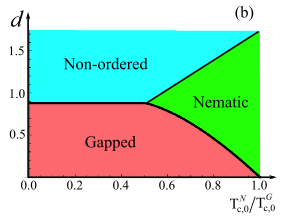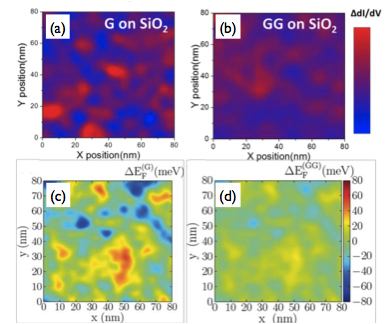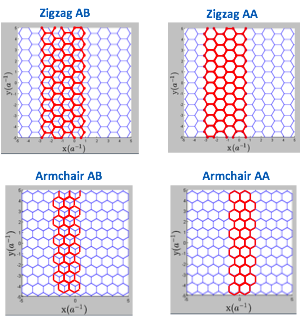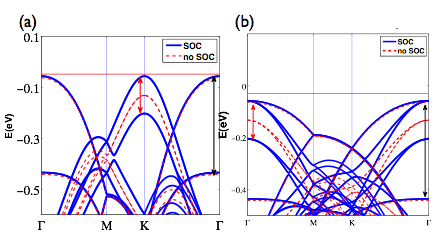Reports: DNI553581-DNI5: Designer Graphene Nanostructures for Heterogeneous Catalysis
Enrico Rossi, PhD, College of William and Mary
In the past twelve months we have continued our study of graphene based heterostructures, and nanostructures. Under the direction of the PI one undergraduate student, Daniel Kang, thre graduate students, Chris Triola, Martin Rodriguez-Vega, Satrio Gani, and one postdoc, Junhua Zhang, have been working on projects supported by the grant.
In recent years experiments have shown that at low temperatures bilayer graphene can be in a spontaneously broken symmetry state. However, different experiments have found results that point to different types of broken symmetry states. Our hypothesis was that the presence of impurities, always unavoidable in real samples, might affect different broken symmetry states differently and that therefore different experiments, having different concentration of impurities, might observe different spontaneously broken symmetry states. We set to verify this hypothesis by carrying out a careful calculation. Our results show that the two most likely classes of ground states, the “nematic” and the “gapped” states, are affected differently by the disorder and therefore provide a natural resolution for the differences observed experimentally. In addition, our work shows that a quantum phase transition between the two broken symmetry states can be driven by changing the density of impurities. This is illustrated by Fig. 1. This work resulted in a paper published in Physical Review B in 2015.
Figure 1. Phase diagram for bilayer graphene in the presence of disorder. On the x-axis is the ratio between the critical temperature, in the absence of disorder, of the "nematic" and "gapped" phase. On the y-axis is the strenght "d" of the disorder, in dimensionless units.
In the past year we have started a collaboration with the experimental group of Prof. Eva Andrei (Rutgers University) on the study of heterostructures formed by two layers of graphene placed on a silicon oxide substrate and in proximity of flakes of hexagonal boron nitride (hBN). Both theoretically and experimentally we find that graphene, when placed on top of another graphene layer has a much higher mobility and much weaker density inhomogeneities, as shown in Fig. 2. Previous experiments had obtained similar results, however our work is the first to quantify the effect. We also found the counterintuitive result that the correlation length of the density inhomogeneities (the “puddle size”) is substantially the same for single-layer graphene and for double-layer graphene. One surprising experimental result is that graphene seems to have a higher mobility even when just in the vicinity (not on top) of hBN: the hBN flake appears to behave effectively as a “vacuum cleaner” for the impurities. We are still in the process to understand this result. This work resulted in a preprint (arXiv:1504.07540) submitted to Nano Letters.
Figure 2. dI/dV maps for single layer graphene “G” (a) and double-layer graphene “GG” (b); the maps reveal the electron (red) hole (blue) puddles resulting from doping inhomogeneity. Calculated maps for single layer (c) and double layer (d) graphene.
We have also continued to work on the properties of graphene nanostructures placed on different substrates. The challenge of this project is that several aspects affect the electronic properties of the nanostructure: dimensions of the nanostructure, nature of the nanostructure's edges, substrate, orientation of the nanostructure with respect to the substrate. We have carried out a systematic study of how these features modify the electronic spectrum of graphene nanostructures. We first considered infinitely long graphene nanoribbons with different edges (zigzag or armchair) stacked in a commensurate configuration (AA or AB) on top of graphene or hBN, as shown in Fig. 3.
Figure 3. Graphene nanoribbons in different commensurate stacking configurations on top of graphene.
We find that when that the substrate significantly modifies the electronic spectrum of the ribbons especially for the case of hBN.
We then considered the case of finite length ribbons placed on hBN and studied in detail the effect of the stacking orientation, parametrized by the angle ϑ as shown in Fig. 4, of the ribbons with respect to the substrate.
Figure 4. Finite size ribbon placed on a hBN substrate with orientation angle ϑ.
We find that when ϑ is close to zero or 60 degrees, a small change of the orientation can significantly modify the spectrum of the graphene nanoribbon, as shown in Fig. 5.
Figure 5. Dependence of the spectrum of a finite size graphene nanoribbon placed on hBN as a function of the stacking angle ϑ.
We have also continued our study of heterostructures formed by single layers of metal dichalcogenides. In particular, we have focused our research to the case of two layers of MoS2 that are stacked with a relative orientation ϑ. We find that by tuning the twist angle the amplitude of the spin-splitting due to the spin-orbit coupling can be modified as one moves from “even” stacking configurations, for which the spin-splitting is zero, to “odd” stacking configurations.
Figure 6. Bands for twisted MoS2 bilayers. (a) Commensurate odd case (θ Å 38.2o) such that the SOC splits the bands at the K and K’ points. (b) Commensurate even case (θ Å 98.2).
The research supported by the grant in the past year has had a very strong impact on the research and career advancement of the students involved and of the PI. It facilitated the preparation of a NSF-CAREER grant that was approved for funding in 2015. It spurred the collaboration of our group and the experimental group of Prof. Eva Andrei (Rutgers). It allowed graduate student Satrio Gani to present his results on graphene nanostructures at the 2015 APS March Meeting. In the Spring of 2015 one graduate student, Christopher Triola, graduated and moved to a postdoctoral position at Nordita in Stockholm (Sweden). For his research work Chris received the “Roy L. Champion Award for Outstanding Achievement in Research” given by the Physics department to the graduate student with the best research achievements.

















